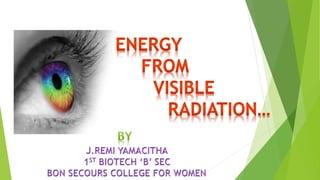
Cell biology
- 2. SYNAPSIS: VISIBLE LIGHT, DOES PHOTOSYNTHESIS USE VISIBLELIGHT, NATURE OF LIGHT, PHOTOSYNTHESIS, PHOTOSYNTHESIS IN EUKARYOTES, ENERGY TRANSFORMATION, CARBON FIXATION,
- 3. VISIBLE LIGHT: Photosynthesis is a process that requires light energy and optimally occurs in the 400 to 700 nm range. This range is also known as visible radiation. Photo synthetically active radiation is the range of visible light that plants can use for photosynthesis.
- 6. DOES PHOTOSYTHESIS USE VISIBLE LIGHT... All of this light is available to plants to use , but they only use visible light in the process of photosynthesis. Infrared ray does not contain enough energy for photosynthesis. This is detrimental to the plant. Plants in fact have pigments to protect them from UV light.
- 7. NATURE OF LIGHT: Light absorbs packets of energy. Another way of saying this all light travels at a constant speed . However all light travel in waves different kinds of light are defined by the wavelength of their light.
- 8. PHOTOSYTHESIS… Photosynthesis(photo=light , synthesis=putting together) It is the process of the formation of simple sugars by green plants , some bacteria and some protistans from water , soil or from carbon dioxide in the air in the presence of sunlight and chlorophyll. By this process of photosynthesis, solar energy is trapped by autotrophic organisms and stored in the form of chemical energy.
- 10. PHOTOSYNTHESIS IN EUKARYOTES… Photosynthesis in plants and algae takes place in chloroplasts and entails two steps: Energy transferring (energy-transduction) reaction {commonly called the light –dependent or light reaction}. Carbon fixation reactions{sometimes inapproxiamately called the dark reaction}
- 12. ENERGY TRANSFER… The energy transferring reactions are photochemical process that take place in two physically separate but chemically linked photosystems:photosystem I (psI) and Photosystem II (psII). Photosystems are pigment molecules that capture energy from the sun and are arranged in the thylakoid membranes of the chloroplasts. The chlorophyll and other pigments of both photo system absorbs light energy , most of which is
- 13. Stored temporarily in energy-rich chemical bonds of ATP (adenosine triphosphate) and the electron carrier NADPH(reduced nicotinamide adenine dinucleotide phosphate). ATP and NADPH supply the energy for the resultant carbon fixation reactions of two. O2 is a by-product of water molecules splitting in the initial energy exchanges of step one. The three products of the energy transfer phase are ATP ,NADPH , O2.
- 15. CARBON FIXATION… The carbon fixation reactions of the second step of Photosynthesis are biochemical and use the energy of ATP and the reducing power of NADPH to repackage The energy in a form that ca be transported and stored , as the carbohydrates sugar and starch. Carbon fixation reaction do not require light; if cellular Energy is available , the reactions occur.
- 16. Plants have developed three different pathways for photosynthetic carbon fixation , one basic procedure and two modifications of it. C3 pathway{also called the Calvin cycle after its 1961 Nobel prize-winning discoverer}. This method is used by most common temperate zone species.
- 18. C4 or HATCH-SLACK PATHWAY… An additional step is added to the Calvin cycle , making it more efficient for plants structurally modified to do so. Many common grasses and tropical plants use this pathway; it is a necessary adaptation in areas of high light intensity , high temperatures or semi-aridity.
- 20. CAM PATHWAY… Another Calvin cycle modification is made by succulents and other plants growing in areas of high temperature , highlight , and low moisture (deserts especially). In this modification ,carbon fixation takes place at night in a pathway similar to C4 photosynthesis and, in addition ,during the day carbon is fixed in the same cells using the C3 pathway.
- 21. This pathway is named for the family of plants , Crassulaceae , in which it was first discovered.
- 22. PRODUCTS… The final products of carbon fixation are a disaccharide sugar ,sucrose ,and a polysaccharide ,starch. The sucrose is formed from two monosaccharide(6- carbon or hexose sugars),glucose ad fructose ,joined together by an extra oxygen atom. Stored energy is transported from cell to cell in plant by the water-soluble sucrose.(In vertebrates ,glucose is the transported sugar.)
- 23. Starch molecules are strings of glucose molecules too large to move through membranes ,and therefore , useful for storing energy. As energy is needed ,the starch is converted to sucrose and transported. Plants build and fuel their bodies from these carbohydrates. Two intermediate carbohydrates(manufactured before sucrose or starch)are the first detectable product in the C3 and C4 pathway. In the C3 pathway- the product is PGA (3-phosphoglycerate)[3 carbons], and in C4 pathway- the first detectable product is oxaloacetate [4 carbons].
- 26. PHOTOSYNTHESIS IN BLUE GREEN ALGAE. Blue green algae is also known as cyanobacteria. Cyanobacteria are sometimes considered algae, but they are actually bacteria(prokaryotic),where the term “algae” is now reserved for eukaryotic organisms. They also derive their energy through photosynthesis , but lack nucleus or membrane bound organelles ,like chloroplast.
- 27. They harvest the sun’s energy ,absorb carbon dioxide and emit oxygen. Like plants and algae ,cyanobacteria contain chlorophyll and convert carbon dioxide to sugar through carbon fixation. Unlike eukaryotic plants and algae,cyanobacteria are prokaryotic organisms. Cyanobacteria are the only bacteria that contain chlorophyll A, a chemical required for oxygenic photosynthesis.
- 28. CYANOBACTERIA OR BLUE-GREEN ALGAE:
- 29. PHOTOSYNTHETIC BACTERIA: Purple , green bacteria and cyanobacteria are photosynthetic Photosynthetic bacteria are able to produce energy from the sunray’s in a process similar to that used by plants. Instead of using chlorophyll to capture sun’s light , these bacteria use compound called bacteriochlorophyll.
- 30. The light reaction of photosynthesis occurs in thylakoid membrane of the chloroplast. Electron carrier molecules are arranged in electron transport chain that produce ATP and NADPH, which temporarily store chemical energy.